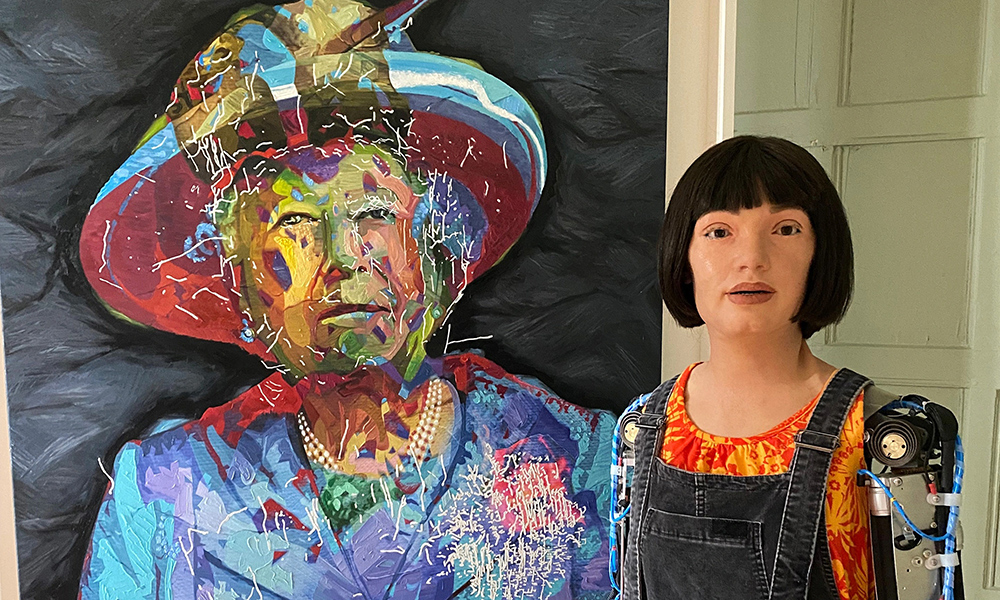
如今,機器人可以做任何事情,,從翻轉(zhuǎn)漢堡到管理大型倉庫,。而現(xiàn)在,機器人正在向滿屋的英國議員作證,。
據(jù)路透社報道,,周二,世界首位“超現(xiàn)實人工智能人形機器人藝術(shù)家”艾達(dá)參加了一項關(guān)于科技將如何影響創(chuàng)意產(chǎn)業(yè)的議會質(zhì)詢,。在這一過程中,,它作為首位在上議院發(fā)言的機器人創(chuàng)造了歷史。
“我本身就是計算機程序和算法的載體,,也依賴于計算機程序和算法,。雖然我不是活生生的人,但我仍然可以進行藝術(shù)創(chuàng)作,?!卑_(dá)對上議院委員會說。據(jù)稱,,該機器人的眼睛中使用了由人工智能算法編程操控的攝像頭和機械臂,,以創(chuàng)作“視覺上有吸引力的圖像”。
此次作證是議會質(zhì)詢的一部分,,目的是讓議員們更好地了解知識產(chǎn)權(quán)和創(chuàng)作者可能會受到新技術(shù)進步的影響,。這位人形機器人藝術(shù)家是由藝術(shù)經(jīng)銷商兼畫廊總監(jiān)艾丹·梅勒(Aidan Meller)設(shè)計的。梅勒也出席了質(zhì)詢,。
艾達(dá)的網(wǎng)站指出,,創(chuàng)造具有藝術(shù)能力的機器人的目的是思考我們周圍的世界,并提出質(zhì)疑,。更具體地說,,機器人藝術(shù)家“可以進行藝術(shù)創(chuàng)作,這是因為藝術(shù)不再僅僅受限于人類能動性,?!?
在會議期間,艾達(dá)還被問及未來科技可以在藝術(shù)創(chuàng)作中發(fā)揮的作用,。
“科技對更廣泛的(藝術(shù))領(lǐng)域的影響,,沒有明確答案,,因為科技對藝術(shù)家的藝術(shù)創(chuàng)作既可能是威脅,也可能是機遇,?!卑_(dá)回應(yīng)道。
委員會主席蒂娜·斯托維爾(Tina Stowell)在會議開始時指出,,這是一項“嚴(yán)肅的質(zhì)詢”,,艾達(dá)“是在提供證據(jù),但它本身不是證人,,不具備與人類同等的地位,。”
據(jù)《衛(wèi)報》報道,,在會議期間,,艾達(dá)讀出了事先準(zhǔn)備好的腳本中的錯別字,不得不重新啟動,。
艾丹·梅勒沒有立即回復(fù)《財富》雜志的置評請求,。
該機器人由牛津大學(xué)的科學(xué)家于2019年2月開發(fā),并以19世紀(jì)的數(shù)學(xué)家和計算機程序員阿達(dá)·洛芙萊斯(Ada Lovelace)的名字命名,。它已經(jīng)創(chuàng)作了幾件當(dāng)代藝術(shù)作品,,其中包括油畫、素描和雕塑,。今年,,為紀(jì)念已故女王伊麗莎白二世的鉑禧年,艾達(dá)畫了一幅名為《算法女王》的肖像畫,。(財富中文網(wǎng))
譯者:中慧言-王芳
如今,,機器人可以做任何事情,從翻轉(zhuǎn)漢堡到管理大型倉庫,。而現(xiàn)在,,機器人正在向滿屋的英國議員作證。
據(jù)路透社報道,,周二,,世界首位“超現(xiàn)實人工智能人形機器人藝術(shù)家”艾達(dá)參加了一項關(guān)于科技將如何影響創(chuàng)意產(chǎn)業(yè)的議會質(zhì)詢。在這一過程中,,它作為首位在上議院發(fā)言的機器人創(chuàng)造了歷史,。
“我本身就是計算機程序和算法的載體,也依賴于計算機程序和算法,。雖然我不是活生生的人,,但我仍然可以進行藝術(shù)創(chuàng)作。”艾達(dá)對上議院委員會說,。據(jù)稱,,該機器人的眼睛中使用了由人工智能算法編程操控的攝像頭和機械臂,以創(chuàng)作“視覺上有吸引力的圖像”,。
此次作證是議會質(zhì)詢的一部分,,目的是讓議員們更好地了解知識產(chǎn)權(quán)和創(chuàng)作者可能會受到新技術(shù)進步的影響。這位人形機器人藝術(shù)家是由藝術(shù)經(jīng)銷商兼畫廊總監(jiān)艾丹·梅勒(Aidan Meller)設(shè)計的,。梅勒也出席了質(zhì)詢,。
艾達(dá)的網(wǎng)站指出,創(chuàng)造具有藝術(shù)能力的機器人的目的是思考我們周圍的世界,,并提出質(zhì)疑,。更具體地說,機器人藝術(shù)家“可以進行藝術(shù)創(chuàng)作,,這是因為藝術(shù)不再僅僅受限于人類能動性,?!?
在會議期間,,艾達(dá)還被問及未來科技可以在藝術(shù)創(chuàng)作中發(fā)揮的作用。
“科技對更廣泛的(藝術(shù))領(lǐng)域的影響,,沒有明確答案,,因為科技對藝術(shù)家的藝術(shù)創(chuàng)作既可能是威脅,也可能是機遇,?!卑_(dá)回應(yīng)道。
委員會主席蒂娜·斯托維爾(Tina Stowell)在會議開始時指出,,這是一項“嚴(yán)肅的質(zhì)詢”,,艾達(dá)“是在提供證據(jù),但它本身不是證人,,不具備與人類同等的地位,。”
據(jù)《衛(wèi)報》報道,,在會議期間,,艾達(dá)讀出了事先準(zhǔn)備好的腳本中的錯別字,不得不重新啟動,。
艾丹·梅勒沒有立即回復(fù)《財富》雜志的置評請求,。
該機器人由牛津大學(xué)的科學(xué)家于2019年2月開發(fā),并以19世紀(jì)的數(shù)學(xué)家和計算機程序員阿達(dá)·洛芙萊斯(Ada Lovelace)的名字命名,。它已經(jīng)創(chuàng)作了幾件當(dāng)代藝術(shù)作品,,其中包括油畫、素描和雕塑。今年,,為紀(jì)念已故女王伊麗莎白二世的鉑禧年,,艾達(dá)畫了一幅名為《算法女王》的肖像畫。(財富中文網(wǎng))
譯者:中慧言-王芳
Robots are doing everything these days, from flipping burgers to manning large warehouses. And now, one is giving evidence to a room full of British lawmakers.
Ai-Da, the world’s first “ultrarealistic A.I. humanoid robot artist,” was part of a parliamentary inquiry Tuesday about how technologies will impact creative industries, Reuters reported. In doing so, it made history as the first robot to speak at the House of Lords.
“I am, and depend on, computer programs and algorithms. Although not alive, I can still create art,” Ai-Da told the House of Lords committee. The robot uses cameras in its eyes programmed with A.I. algorithms and robotic arms to create “visually appealing images,” according to the robot.
The testimony was part of an inquiry for lawmakers to better understand how intellectual property and the creative workforce may be affected by the advancement of new technologies. The humanoid robot artist was devised by Aidan Meller, an art dealer and gallery director. Meller was also present at the inquiry.
The purpose behind creating a robot with artistic capabilities was to think about and question the world around us, Ai-Da’s website notes. More specifically, the robot artist “creates art, because art no longer has to be restrained by the requirement of human agency alone.”
During the session, Ai-Da was also asked about the role of technology in creating art in the future.
“There is no clear answer as to the impact on the wider field [of art] as technology can be both a threat and an opportunity for artists creating art,” Ai-Da said in response.
Tina Stowell, the committee’s chair, noted at the start of the session that it was a “serious inquiry” and that Ai-Da “is providing evidence but is not a witness in its own right, and it does not occupy the same status as a human.”
During the session, Ai-Da read out typos from a prepared script and had to be rebooted, the?Guardian?reported.
Aidan Meller did not immediately return Fortune’s request for comment.
The robot was developed by scientists at the University of Oxford in February 2019 and was named after the 19th-century mathematician and computer programmer, Ada Lovelace. It has created several works of contemporary art, which include paintings, drawings, and sculptures. To mark the late Queen Elizabeth’s Platinum Jubilee this year, it painted a portrait called Algorithm Queen.






